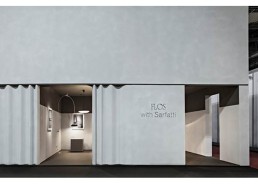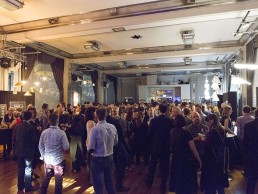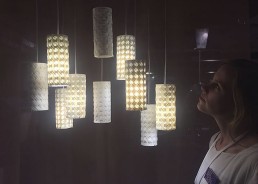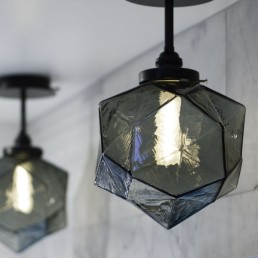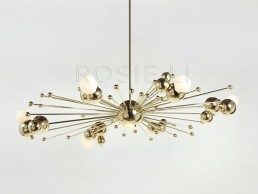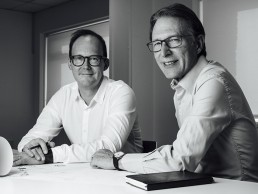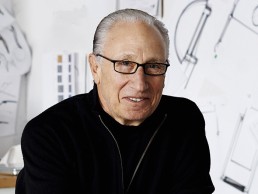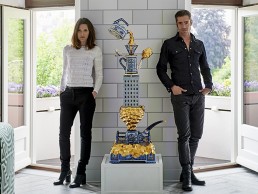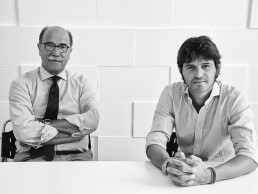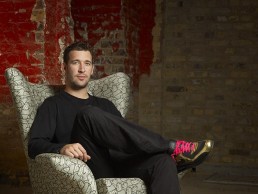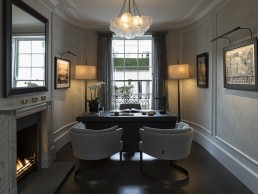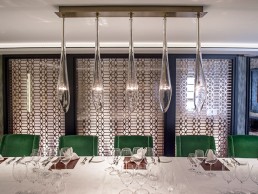Flos announces new collaboration
(Italy) Following the Euroluce launch of Flos with Sarafatti, Alessandro’s Sarfatti’s lighting brand, Astep, will be distributing products from Italian lighting legend Gino Sarfatti under Flos license.
Both companies will continue to explore the vast Arteluce collection selectively re-issuing luminaires of contemporary design.
They will, in addition to the existing re-issued models form a new prestigious collection named ‘Flos with Sarafatti’.
darc awards winners announced
(UK) The darc awards / decorative took place at the beautiful Art Deco Bloomsbury Ballroom in London on the 19th of May.
Around 500 people attended the awards party by designers, for designers to enjoy gin, jazz and the best decorative lighting in the industry.
Over 200 entries from 30 countries were counted to determine our winners (a comprehensive list can be found here).
A huge thank you to all who took part, for making the awards and the after party a darc night to remember.
Woven Light
(US) Combining extensive material research with the simple mission to put human experience at the centre of their work, Alissanienke create materials, objects and installations that trigger curiosity and interaction.
The Netherlands-based studio launched Woven Light, an extraordinary collection of porcelain pendant lamps at this years Wanted Design Manhattan.
The innovative application of lasercut porcelain is the result of research on overlapping patterns, playing with transparency and a unique interpretation of surface design.
By switching between daylight and artificial light, the delicately woven porcelain shows its transparency to reveal another geometrical pattern.
The Union of Steel and Glass
(US) Vitreluxe, the contemporary design-driven glass studio based in Portland OR, introduced a new series of lighting at ICFF, May 21-24th, available through retailers, interior designers, hospitality and contract specifiers beginning June 2017.
Founded by Award winning artist, designer, craftsmen and educator, Lynn Everett Read in 1999 with the desire to build an advanced glass studio with some unique alterations to allow for versatility and efficiency.
Lynn’s early pursuit in watercolour paved the way to an interest in glass because of its transparency of colour, optical intrigue, malleability and material versatility. His creative spirit and passion for glass has intensified since his first apprenticeship in a glassblowing studio.
A diverse artistic background ranging from painting, sculpture, woodworking and theatrical set-building continues to play an important role in Lynn’s inventive approach to glass working.
Read utilises soda-lime glass, which allows for a long, steady working time. Unlike bottle glass, the formula lets the artist alter the shape and maintain the heat long enough to painstakingly create the objects.
“The physical element of glassblowing is dynamic and requires choreography. It’s a studied meditation and a dress rehearsal,” explains Read.
‘We move through the studio as a group from the furnace, where we gather molten glass at 2150 degrees, to our workbench, where we shape the glass with hand tools to achieve the desired volume, thickness and form. We work steadily from start to finish as if in scenes of a play. We can’t stop to break; we must keep the glass hot and moving until the finality.”
Rosie Li Debuts ‘Dots & Dashes’ at ICFF
(US) Rosie Li Studio announced the launch of its new 2017 collection ‘Dots & Dashes’ during New York Design Week at ICFF (May 21 – 24)
Following the success of past launches, Dots & Dashes sees whimsical forms grounded in classic materials true to the design studios aesthetic (brass and glass). Science and nature continues to shape the identity of the pieces, as it has in past collections, with hints of cellular patterns and ancient leaf clusters.
The Paloma Chandelier, inspired by particle collisions and the Palomar Observatory is a dynamic take on the classic 50’s Sputnik Chandelier. Six lights surround one key down light, allowing light to hover gently over its user/space.
Further releases include Hesse 07 Light Chandelier, a homage to Eva Hess’s sculptural rope installations and neutral spiral twist and the Laurel 07 Leaf Chandelier Inspired by laurel wreaths from ancient Rome.
‘This year was about loosening up and taking a more playful approach to my work. I wanted to push the boundaries of my design language to better express the beautiful moments I found in nature – from the helical twist in the Laurel Chandelier to the asymmetrical burst of the Paloma chandelier. The Collection conveys a strong sense of growth and movement that I hope appeals to viewers on a deeper and intrinsic level”. – Rosie Li.
“Good design demands simplicity.”
UK product designers John Fearon and James Bassant have 20 years experience in designing for the hotel market. With specialist knowledge of bathroom lighting, here, they share their expertise on how to ‘get it right’.
With a shared commitment to British lighting design, John Fearon and James Bassant are passionate about quality and precision and while their company Astro Lighting may have been born out of Bassant’s damp and gloomy basement, today it stands 20 years in the industry, working to the creative ethos of its founders – that good design demands simplicity.
With experience of providing lighting to spaces across every sector, Fearon and Bassant understand well the importance of lighting within the hotel sector and specialise in bathroom lighting in particular. As one of the most underserviced areas of lighting, hotel bathrooms can often be poorly lit. An integral element of a guest’s stay, this experience can greatly affect the perception of a hotel and the consideration it puts into a guest’s comfort.
“No one was taking bathroom lighting on when we started out, but in 2000 new regulations for electrical equipment in bathrooms were introduced, so we went into it in a big way and as such gained a bit of a reputation in that area,” says Fearon. “As we got more involved in bathroom lighting we began designing for other areas of hotels; we’ve become particularly well known for our reading lights in fact.”
At the heart of a hotel’s focus is the guest experience - lighting plays a huge part in the way someone experiences any space they enter, especially an unfamiliar one. When people go to hotels, they’re looking for a home away from home experience a lot of the time. They want instant relaxation in a space to rest and recharge with a good night’s sleep.
“Lighting makes an enormous difference to the mood and ambience of a space, particularly as it gets dark,” says Bassant. “It makes an enormous difference to how you feel and how you occupy the space. Of course you have to have nice furniture, a nice location and a view, but some of these things – such as a view - you can’t do anything about. You can do something about the lighting, and it’s important to make the most of that choice.”
“You’ve only got to see how much trouble hotels go through to get the lighting right,” adds Fearon. “They do a mock up room with the bedding and everything, but if the lighting looks horrible at this stage, then everything will look horrible. These days, you get a lot of functionality in a high-end hotel. There are so many different types of lighting that you can adjust and set to whatever levels you want. It’s really so much more than just a light in the middle of the room.”
Each individual hotel requires a different type of lighting design and specification of product to reflect its personality, and often its size. Despite these differences, the importance of lighting remains integral as Fearon explains: “Boutique hotels tend to be more quirky, more personalised. As such, they often use vintage and industrial inspired lighting. I think typically by the side of the bed, you won’t get the decorative table light you might get in a big hotel, but you might get something like a task light either side of the bed.”
One of the most important differences between hotel and residential or retail lighting is scale. This is something the design duo latched on to in their early years, but as they have moved more into hotels, realised that as scale increased, the lights needed to feel more substantial to match.
“You almost couldn’t go too big,” says Fearon. “It’s what makes the room and the lighting feel different to what you have at home. So I think with independent boutique style hotels, people see the lighting and it makes them realise they could do the same at home.”
As part of this process, the techniques of lighting designers in hotels are transferring across to domestic use. “In bathrooms, people are going for two statement pieces either side of a mirror, which makes a big difference,” says Bassant. “It’s about scale, drama and theatre, and transferring that over to domestic spaces. It might be easier to put a simple backlit mirror in, but when you go to a boutique hotel, or five-star hotel, they don’t do that at all. They will have a really nice light either side of the mirror to give good illumination on the face, while keeping the design stylish.
“I think a lot of architects are guilty of taking the easier option of only using recessed down lighting because it looks great on the plan, but actually it doesn’t offer very good illumination in the bathroom because it’s rather flat. When the light is bad, it make you look about ten years older than you actually are by casting shadows under your eyes, nose and chin. If you put a light either side of the mirror, you get nice even illumination, and you look how you actually look.”
With Bassant and Fearon’s wealth of experience in the industry, they have also seen decorative lighting trends within hotels change over the years, becoming more sophisticated with an increase in quality. Switches either side of the bed have become more prevalent, while an increase in LED lighting suggests that hotels are prepared to take lighting more seriously with appropriate budgets. They are recognising how it enhances the space and the guest experience, while giving them an edge over competitors who do not consider it an essential feature.
“Lighting scheme designers are relatively new,” said Bassant. “It’s quite a big business now, whereas before you might have gone into an old fashioned hotel with nothing particularly creative. Now there’s a stand alone designer who just concentrates on lighting working with an interior designer doing the colour scheme and fabrics to make sure these elements come together properly. I think that says a lot in itself.”
A particular trend that has found its way to the forefront of lighting design in hotels is the use of dimmability and colour change, in tune with circadian rhythm.
Fearon explains: “First thing in the morning, you have a whiter, nearly blue light, to wake you up and stimulate. During the day, as it reaches evening, it starts to draw back to a redder spectrum, and as you get closer and closer to bedtime, the light reaches a deeper and deeper red. It tunes in to the circadian rhythm in the body to be ready for sleep. When you’re staying in hotels and flying through time zones but your body is fighting against you, the lighting can work to trick your body into thinking it’s a different time of day. I think that’s going to catch on more and more.”
In terms of decorative fixtures in hotels, we’re seeing a wider variety of different finishes, with matte gold taking first place. According to Fearon: “People want drama and scale. Big antique brass finishes as well as matte brass, are things we’re seeing a lot of. Once upon a time we could have just done chrome for hotel bathroom lighting but now we’re doing black, white, chrome, nickel, brushes, stainless steels, copper, matte gold and antique gold! I think people just want to be different. It may take a while to get used to, but people want options.”
From a technical point of view, an awful lot of time is now spent converting popular lines to LED. “LED is lighting nowadays,” says Bassant. “Pretty much everything we have, we do an LED version of, and that’s important. We need to keep going in this direction, as well as continuing to provide people with choices and versatility.”
Through a combination of chance encounters and an unwavering dedication to succeed, Bassant and Fearon have built their reputation into what it is today – having started in a basement with two desks and a phone line, into leading designers of decorative lighting products that light up spaces all over the world. Their products provide hotels with the variety and choice they seek in working to satisfy guests, rendering decorative lighting an integral character in the guests’ stories of their time spent in a home away from home.
Indulging in Comfort
Lighting designer Robert Sonneman has 50 years experience working across various hospitality environments. Here, he shares his thoughts on what makes ideal lighting for hotels.
“Today’s hotel guests are seeking a transformative experience during their stay that relieves them from their daily pressures and invites them to relax in an indulgent and comforting place. A hotel offers the opportunity to explore scale in the pursuit of grandeur and excite the notion of fantasy. It builds anticipation of the experience and transports one to a different reality of service and indulgence.
Lighting is a critical component of setting the environment for the objective of the moment and the overall perception of the property. Colour, texture, location, utility and activity are perceived by the tone, quality and colour of the light that guests encounter. Ultimately, we see what we light; so our mood is reflected in our perception of the space.
Unlike transient properties, we experience our homes as a place to conduct our daily lives. In our homes, lighting is often more about domestic activities than it is about mood and ambience. Home activities can be utilitarian, entertaining and relaxing; therefore, the lighting should be capable of adjustment to serve varied circumstances.
For the high-end hotel, lighting can set the overall tone of drama and /or luxury, or it can create the businesslike atmosphere of a men’s club. It can be the focal point of a space, the jewellery in the room.
Hospitality environments exist to provide a range of services to guests often using the same spaces for different activities. Public spaces, bars, lobbies and restaurants are often used for casual gatherings, receptions and events, but not always at the same time of day or for like-minded guests. The challenge is to create ambience and moods that are right for the activity, and a luxury hospitality space can accomplish multi-use lighting by managed systems of changeable colour, quality and intensity.
Application is critical to the success and relevance of a lighting design. My team and I work with architects and designers to realise their aesthetic vision while achieving the intended utility of the space. Bringing a new or interesting approach to each design objective is made more challenging by the need to avoid contrivance. There is a balance between restraint and excess, and the goal is to do things better, that work well.
Often the designer’s vision needs assistance to achieve the functional requirements. In addition, we need to consider the supplemental lighting and its impact on the effectiveness of the decorative architectural lighting. Lighting is one critical element of many that has to fulfill the utility of its application.
Technology has continued to open new opportunities for these applications. I strive to push the boundaries of innovation to achieve the perfect balance between art and technology. For me, this is the dawn of the place I always wanted to be in creatively because technology has burst open the possibilities of imagination. Integration is the key to the evolution of lighting science. No longer generated by burning fuel or filaments, lighting is provided by exciting electronic signals to produce luminous energy.
LEDs can be programmed and controlled to provide the perfect mood of illumination to ideally accommodate the time of day, weather, or a special event, creating a memorable experience of luxury. Lighting systems can also respond to occupancy and time of day, or be set in synchronous harmony to music or levels of conversation and noise. Varying the lighting for different utilities can determine the mood and serve to invite lingering or excite exodus.
My focus today is on using the latest technologies to innovate new directions for modern lighting. The Sonneman - A Way of Light brand commitment is rooted in the principle of form from function, and speaks to the belief that good design works well. In 2017, we introduced new collections of pendants, sconces, lighting system components and luminaires, and outdoor LEDs. For the hospitality segment, many of our lighting designs are ideally suited to deliver the perfect mix of sophisticated design and illumination to upscale environments.
For example, Champagne Bubbles, which can be hung singly over a bar or in clusters over a lobby seating area, offer a majestic appeal to an upscale hospitality space. Also introduced this year, the Waveforms family of pendants can be hung in various sizes and lengths to add a dramatic ebb and flow feel to a lounge or restaurant.
Our Suspenders structural LED system was also expanded this year with new luminaires, configuration possibilities, and lighting functionality. This delicately scaled, modular lighting system offers endless possibilities for design configuration and illumination for high-end hotels. Suspended in a lobby, event or meeting room, or over a bar, Suspenders can be intricately scaled – horizontally and vertically – to provide simple, yet dramatic luxury to any setting. Created to serve both decorative and functional purposes, the foundational system provides the ability to add focused light or the soft glow of indirect illumination to any application.
For outdoor spaces, innovations in exterior decorative lighting are also being driven by the latest LED technologies. Recent advances offer the power, efficiency, and colour variability to illuminate and set the mood and tone of luxury hotel’s entries, walkways and open-air spaces.
Built into paths, pavings, walls, under eaves, doorways, and planted areas, LED exterior systems set programmable illumination for the party at the pool, weddings or the night time vista of the grounds. Controllability and infinite possibilities for integration into the buildings and site conditions create opportunities to paint the landscape with fantasy creating illumination.
When designing lighting products, I avoid trends as guides to inspiration, seeing design as style, not fashion. Fashion is six months, and style is 10 years. I don’t try to be different for its own sake. I like the luxury of a clean space and the grandeur of scale. I like simplicity, but enjoy the comfort of well-designed and well-placed seating and surfaces with contextual points of interest. I like being engaged with the energy of people in an exciting and stimulating experience, and high-end hotels provide that opportunity for engagement.
As an architectural practitioner and industrial designer, no single area has absorbed my ongoing curiosity as much as my 50-year pursuit in lighting innovation. LED has changed our universe because it has empowered us to imagine and create design in the context of a new scale and with new form factors. Freed from the limitations imposed by the heat and size of conventional filament burning sources, advancements in technology are providing the opportunity to reimagine illumination in innovative new ways. As a modernist with a thirst to do more, I am thrilled to always be engaged and seeking what’s next.”
Job Smeets & Nynke Tynagel
Studio Job recently collaborated with Italian lighting brand Slamp on a collection that is its most extreme yet. Launched at Euroluce, darc takes a deeper look into the influences behind the design.
Ever since their first encounter at the Dutch Design Academy in Eindhoven, Netherlands, Job Smeets and Nynke Tynagel have been soul mates in both life and design.
Today, they share two cats; a love for the everyday; a passion for lighting objects and have become contemporary cultural pioneers, revolutionising common preconceptions about the realms of art and design.
In their most recent work they find themselves collaborating for the first time with Italian lighting brand Slamp – bringing their iconic graphics to seven new lamps that make up ‘The Lightning Archives of Studio Job’ introduced at this year’s Euroluce.
Iconic semantics meet Dadaist derivations in Studio Job’s ode to the Tube, bringing a daring poetic aura to the historic Slamp masterpiece, first producted in the early ‘90s. The collection is illuminated by a strong, surrealist identity born of creative expression: Labyrinth, Love Peace Joy, Perished, Peace Skull, Faena Art, Bananas, and L’Afrique.
Luscious smiling lips, dancing animal skeletons, pop-art fruit, references to the Reinaissance and superstitious frights, are all part of the iconic quotidian, seemingly out of order, yet perfectly recognisable thanks to a series of graphic design principles.
Smeets and Tynagel’s work is defined by their meticulous attention to detail, making every piece unique. Painted, rounded profiles, matching or contrasting semi-spheric buttons in predominant colours and specifically designed wire coverings are some of the various details used to complete their designs. Dense metaphoric suggestions, transposed cult references and two-dimensional forms take on depth when printed on transparent Cristalflex superimposed on an Opalflex layer, transmitting the light uniformly. The result is pure extremism, and the Tubes are a complete work of art, bathed in semantics, brought forth from a ‘cabinet of curiosities’ true to Studio Job’s style.
Striving towards the creation of Gesamtkunstwerk, which sometimes translates poorly to aesthetics, but more precisely means a synthesis of the arts or universal artwork, Smeets and Tynagel often reference the German composer Richard Wagner’s aesthetic ideals in their practice; seeking and moving towards the clearest and most profound expression of the stories and mythologies with which they engage and bring to life.
Studio Job’s work is in the true spirit of the Renaissance where techniques are interchanged and where disciplines are disregarded towards creation of the new; where ideas and imagery are appropriated with ease, regardless of geographic or conceptual boundaries and repurposed into something new – where culture, spirituality and aesthetics converge in one cacophonous space and where production and craftsmanship yield one-of-a-kind objects and environments.
Looking back to where it all began, when asked what has influenced their designs over the years, the duo’s answers ranges from Miffy and Roy Lichtenstein to Bowie.
“When I was a kid, I wanted to be free, like a famous pop star,” Smeets tells darc. “When I was really young, I learned to draw at the kitchen table with my father who was an artist and antique dealer. Following school, there was only one course that really made me curious – Conceptual Design, which I did while balancing an ‘education’ in combining fitness with drinking and smoking weed!”
“My father was an art director for Weaving Mill de Ploeg and my mother a textile designer,” Tynagel says. “I have been passionate about visual arts all my life but chose to study Graphic Applied Arts. I’m also really passionate about classical music, movies, art, cooking, friends and love.”
“For me, it’s about collecting and travelling, travelling and collecting, as well as sports,” adds Smeets. “And yes, love of course!”
Through Studio Job, the designers have crafted a body of work that draws upon classical, popular and contemporary design and visual art. The symbolism and iconography that Studio Job creates is heraldic and regal, even in its pop cartoonish imagery. As sleek as the work can be, it is also instinctual and almost primal. Smeets describes their work as ‘New Gothic’, while Tynagel often speaks of the work by referencing a symphony orchestra.
The studio itself is made up of traditional craftsmen and contemporary industrial professionals from sculptors, furniture makers and painters to specialists in cast bronze, stained-glass, laser cutting and 3D printing, all of whom work to realise the designs in whatever final form may be required. This flexibility of application and realisation frees the studio from the confines of any one particular medium and allows for the work to speak for itself.
“Looking back on our work we’ve really done some brave, pioneering things by introducing ‘art’ into design,” they tell darc. “Today, it has developed into a real, working model but 20 years ago, it didn’t exist… we just followed a certain path at the time. When we started design was still about functionalism… Modernistic anchors. Now, design can be so much more. It can reflect time, it can be abstract… it’s as though we have slipped into a Renaissance period.
“Design has great facets,” Smeets and Tynagel continue. “You can reach a large audience. Still design, like fashion, is all about speed… One, after another… More, more and more. Sometimes we wish the pace was a little slower, but then we have so many plans and still so much to do and when it all comes together, when a piece is finished that moment of joy and relief is what it’s all about… the birth of something.”
While the pair note that product design is driven by a commercial engine of producing and selling as many products as possible, for them thankfully there is now sculptural design that has it’s own parameters and when commenting on trends within design, tell darc: “Every interesting piece or product will stand the test of time and will be part of history. Look at the whole sculpture thing… in a way it is a NEO style. Look at the 16th Century as well, another renaissance period. The best example is the Green Vault in Dresden, commissioned by August the Strong, a billionaire of his time. Good product design needs to have authenticity, and should be well made with a raw soul.”
Francesco Favaretto
Favaretto & Partners has a rich history in the Italian design industry. Having collaborated with numerous design teams on countless products, their most recent work sees them enter the world of lighting, as Helen Fletcher discovers.
Curiosity, tenacity and a passion for research have characterised the work of Favaretto + Partners for more than 40 years. The design studio was founded in 1973 by Paolo Favaretto and went on to be one of the first in Italy to engage in business internationally with companies in North America, Europe and Asia.
Ever since, a reputation for reliability and competence have helped the studio establish long-lasting relationships; using a variety of production methods, the studio prides itself on design precision and a keen interest in research within form and function innovation.
Born in Padua in 1950, Paulo graduated in Architecture at the Higher Institute of Architecture in Venice, IUAV where he attended lectures conducted by Professor Carlo Scarpa. After graduating, he immediately launched his freelance profession, followed by the launch of the design studio that today bears his name. An active designer and consultant for the industry, he has collaborated with many prestigious Italian and foreign companies and has won a wide variety of important prizes and awards.
A past president of the Delegation of Veneto and Trentino Alto Adige of the ADI-Association for Industrial Design, Paolo was also founder and president of IIDD-Italian Design Disability Institute (now DFA-Design for All) and an executive member of the DFA; he currently represents Europe ADI at BEDA-Bureau of European Design Associations.
Today, the designer holds conferences and lectures at international design universities and institutes, including undergraduate courses in Industrial Design at the Politecnico of Milan and the IUAV of Venice; the Italia Design School of Padova; and National College of Art and Design in Dublin to name just a few.
In 2009, Paolo’s son Francesco Favaretto joined the studio – taking the business even further into wider areas of design. As such, Favaretto + Partners’ work can be seen across a multitude of platforms from furniture and lighting, to home décor. Born in 1983 in Padua, Francesco graduated in Industrial Design from the Institute University Architecture of Venice, having attended lectures of architect and designer Tobia Scarpa.
Francesco’s design career started off in the fashion industry, co-founding his own brand Mofodesign following graduation. Once the brand was established, a new challenge was in order and so the young designer set off for Canada to start a new career in industrial design. “Upon my return, I decided to continue in the field of industrial design and approached my father about joining forces to set up Favaretto + Partners - the rest is history,” says Francesco. “I moved from fashion to industrial design because I needed something more durable rather than something that lasted for a season only… Today however, product design is moving more towards the fashion industry style. Product lifespan is becoming shorter and shorter. Perhaps I should swap back to fashion?”
For Paolo, industrial design has been a lifelong passion, spending all of his time drawing and experimenting, whether with pen, pencil or watercolours. “I have always been inspired by the old masters,” he tells darc. “But one thing I always try and remember when designing products is that it has to improve someone’s life.”
While lighting is one of the fields less explored by the design studio, it has, in the last three years collaborated with Italian brands Vistosi and Torremato to create three new product lines, all of which were showcased at this year’s Euroluce. “Our approach to design does not change whether it’s a lamp or a chair,” Francesco says. “For me, it is important to know the DNA of a client and their industrial process, this influences the end design.”
“Light is important in a lamp, just as comfort is in a chair,” adds Paolo. “My personal goal every time I start to think about a new product is that a design should not only look aesthetically pleasing but should be practical and make life that little bit easier. Lighting is a really important element to any space in order to create an emotional feeling. From a functional point of view, lighting has to help guide the eye from dark to light.”
Favaretto + Partners’ design for Torremato is the Metissage collection. Introduced at Euroluce, the collection can be defined as a mixture of cultures, flavours, travel and aesthetic influences that have inspired the designers over the last few years. “We are constantly stimulated by external influences from an unstoppable changing, of everything that surrounds us,” the duo tells darc. “It is the designer’s task to pick up and assimilate these influences, in order to translate them into useful and original products.”
For the Metissage collection Favaretto + Partners started to think about the archetype of the lamp ‘the lantern’ that is an icon of lighting. With the actualisation of the lantern as inspiration, it comes from the sophisticated decorative effect of the glass – called sublimation, which is digitally printed. Metissage blends together classic, simple, timeless shapes with a futuristic vision and at the forefront of the idea is customisable digital printing technology. This collection combines the essential architecture of the structure with the particular effects of light on the different patterns of the glass. The flexibility of Metissage is comes from the dimensional modularity of the product, but also through the ability to choose the design of the glass, thus giving the user the opportunity of having their own personal custom-made lamp.
Over on the Vistosi Euroluce stand, Jube was born from the union of two types of blown glass. Essential, sinuous and delicate, once assembled together they create a play of overlapping and a tone on tone effect with a retro vintage charm. Thanks to a powerful water jet, which allows holes of very large diameters to be created on the glass, the combination of the different glass is integrated in the best way, avoiding the exposure of edges and making them look as though they were a single piece. The lower glass is glossy and white, while the upper glass is one of three colour variants – antique green, smoked and scorched earth. The LED light source, with integrated module, allows for a diffuse and powerful light.
Also new for Vistosi is the Sata lamp, which has been developed off the back of the Trepai product shown at Euroluce 2013, which used bi-material of wood and crystal. In this latest edition, the wood is even more emphasised and the collection includes three versions: suspension, table and floor, which is easily the most characteristic out of the three.
Talking design in general, for Paolo, when asked about notable collaborations during his career, he tells darc: “Several years ago I designed some lamps for Firme Di Vetro, Murano Due and also for a Japanese brand called Koizumi. We also started collaborating with a Chinese brand called Candelah in 2012.”
“For me, it is our work with Vistosi,” says Francesco. “I am really proud of our work designing the first multi-material lighting range for them. I’m excited to see how Metissage designed for Torremato will be received also.”
Time to Shine
While his dream of becoming a stuntman might not have panned out, other childhood loves such as James Bond and anything sci-fi certainly play a part in British designer Ben Rousseau’s product designs, as Helen Fletcher discovers.
With a background as colourful as his latest clock design, the career of British designer Ben Rousseau could have gone down a number of routes at any given time. Whether it was his childhood dream of becoming a stuntman; or his time in the events industry working with clients including Xbox and on music events in Ibiza; or dressing up as a children’s clown entertainer for a Swedish cruise ship (and at 6ft 4ins that’s a pretty terrifying thought), he’s almost done it all…
Thankfully for the design industry, Rousseau knew from an early age that his calling was something that sat between art, design and engineering. “My dad had classic motorbikes all of his life and had an old 1955 Chevy bell air hot rod when I was at school,” he tells darc. “It was mirror black and amazing! I was really into what some of the American hot rod designers such as Boyd Coddington and so on were doing, I was amazed by the tricked out interiors, the lighting, and wheel design as much as I was with the amazing bodywork on the vehicles.”
Born in Australia, but with an upbringing in England’s oldest recorded town of Colchester, a younger Rousseau soon became tired of the town’s historical tales and children’s rhyme references of Humpty Dumpty and Twinkle Twinkle Little Star and following his time at Colchester Institute, left to pursue a BA degree in Product and Industrial Design at Middlesex University in North London.
“I left Colchester institute art department wanting to make film sets and special effects models, so went to study 3D model making at KIADW (Kent Institute of Art and Design) in Rochester. While there I spent a lot of time in the workshop and also dj’ing, putting on parties at the weekend. This turned my attention to event props and creating nightclub furniture and hospitality interiors.
“I always felt I had been blessed with plenty of imagination but needed to learn how to get things made, how to use the precision machines I’d seen making those cool hot rods in the States.”
So, throughout his studying Rousseau befriended the workshop technicians, learning how to use the machines, the lathes, drills, milling machines and so on - taking in advice on materials and limitations of assembly and so on. Learning how to fabricate and build while ensuring his designs could actually be made and if not, then pushing the boundaries of what people and machines could do to get them produced.
It was Rousseau’s university partying days that in fact saw him first introduced to light. Spending a lot of his spare time in “crummy night clubs”, there was always something about UV light and mirror balls that mesmerised him. “Lighting always did something to me and I knew that somehow it would be the secret ingredient in my design work that meant it was different to the person next to me.
“I found LEDs after my trip to Sweden as a clown, my partner for the trip Jai Drew was Captain Hook and a ‘wannabe inventor’, a sci-fi nerd and a great guy, but very clever with taking machines like old photocopiers apart and making something completely different with them, he showed me how to play with basic electronics and afterwards we started illuminating small rods of acrylic, I knew the seed was planted for an obsession with the beauty of light.”
Rousseau’s end of year piece at Middlesex University was a black American walnut table that featured a lighting tray below it, made of Live Edge acrylic, which lights up when it absorbs light through the main surface of the material and forces it to the edges. It was the culmination of everything he had learnt; his maturing that led to an aesthetically pleasing style; an appreciation of quality materials; and the skills to build it all himself.
“Shin Azumi gave me possibly the most poignant bit of advice I’ve ever had,” says Rousseau. “The early designs for the table were really over designed and he said ‘just think about how you can simplify the design, look at what you take out to make it more elegant’. I look back at the early sketches with horror as they were so bulky and hideous. I think of those words almost every time I do anything, it’s built in me now.”
As a child of the ‘80s, Rousseau sites his love of Star Wars and James Bond as some key early influences for his designs of today. “Ken Adam who designed all the ‘bad guy’ sets in the early Bond films was my first hero and then Ralph Mcquirrie who designed all the sets and artwork for the early Star Wars films.”
Today, the sci-fi film theme continues for Rousseau, with the film Ex Machina a particular inspiration for the designer.
“It was like watching a film pulled straight from my imagination! Modern architecture, concept car design and modern fancy hotels all help add pockets of inspiration here and there, as well.”
The next steppingstone in Rousseau’s career came after he was selected to represent Middlesex University at the new designers show. Following this, Max Fraser asked Rousseau to be part of the Design UK show at Designers Block and then again in Milan the following year. “I got my first decent commission after the Milan show, building a bar and lots of feature items in a lovely property in Beaconsfield. That customer is still one of my biggest supporters. I also met a guy there that is now one of the head honchos at Philips Lighting, he brought over some Color Kinetics kit to show me - it was amazing! Stunning colour changing LED technology blew me away and he’s been a good contact ever since.”
With a style that can be best described as modern luxury with a flavour of sci-fi and automotive influence, Rousseau has been incorporating light into furniture and event spaces for about sixteen years, telling darc: “It’s the one thing most people can’t imagine how good it will look until it’s finished and in its final setting. It has the power to completely change a space or item.
“Lighting should be used to make the space have a pre-planned feel to it. In a showroom it should be about showing off the product to its best capability; in a bedroom the light should be soft enough to feel at your most relaxed and happy, so every space is different as the tasks are different. People will buy a house because of the good light and the good feelings. I like my products to have a secondary element that gives a double whammy of good feeling. My moon lights give off a nice warm glow but also create stunning shadows all around the room, my Tempus clocks are kinetic light wall artworks but actually work as a 12hr clock as well.”
Tempus came about after Rousseau created a collection of wall-mounted artworks that used repeated precision geometrics. “I kept going back to using 60 repeated shapes which planted the seed that these designs could then relate to a time piece of some sort,” he says. “I have been using engraved and laser cut acrylic with lighting from the start, varying between polished and frosted surfaces to create form and visual impact inside surfaces. With individually addressable LEDs, I had all the elements I needed to create my newest ideas.”
Before Tempus, Rousseau had noticed that he would just stop and stare at illuminated art pieces. “It felt as though I should be watching something happen,” he says. “I wanted to create a piece that was primarily a beautiful piece of illuminated technical art.”
The piece builds in segments over the course of each minute and hour in a very hypnotic way. “I love to see people view it for the first time when they are instantly attracted to it. They are hypnotised by the seconds building up and then the next minute appears and they suddenly think, ‘is this some sort of time piece?’ They usually count the pieces and get it… but it’s when I show people the colour patterns that they’re pretty blown away.”
The idea for Tempus came around six years ago, but it wasn’t until one of Rousseau’s business advisers suggested creating something unique that he could send potential clients as a type of calling card before having met them. “I thought the illuminated clock would be an idea no one had seen and would certainly get some attention,” says Rousseau. “So I made the first prototype… When I saw it for the first time I knew it was the start of something quite special. It was mesmerising, the opportunities for it were flooding through my brain!
“Tempus is a clock for the digital generation… a timepiece for the 21st Century. I like the fact that early time pieces used sunlight and shadow to tell time, I absolutely love my watches and they almost all have hands but Tempus can do so much more than just tell the time, it’s done so in a way that is visual and stimulating. It can be colour coded to match weather patterns; it can be connected to all sorts of apps and web data so it changes with information; it can flash to warn people of danger detected in the building… and it will be able to dance to music once I’ve developed the app I want for it.”
Tempus has been designed to be highly versatile with its wide range of material options and lighting options, from beautiful architectural reception areas in large corporate offices to luxury hotel lobbies and hospitality premises. There are highly personalised options to suit the highend residential markets and then lightweight versions for use on super yachts and planes.
Talking with Rousseau on design in general, the notion of ‘throw away’ design is not one that sits comfortably with him, telling darc: “One of the best product designs of my generation is the Technics 1210 turntable, first launched in 1972 and still used in the same way today. I still have a pair myself and will keep using them forever, a piece of great usable product that has been a stable for longer than any other product I can think of, it has a real place in my heart.
“In terms of lighting, I love the Laser Pod Chris Levine designed, I put one in my bathroom ceiling so it casts a lovely moving glow over you and tickles you with laser beams as you look out of the window into the stars from the bath below.
“A good product needs to work well and do the job it was intended but I believe you buy with your heart and that comes down to something being attractive in the first instance. Whether it’s a light fitting, a motorbike, a chair or a pair of shoes, you must be attracted to it to buy it first off, then you get to use it and fall in love with how well it works. A good product is one that pushes the boundaries of technology, material capabilities and improves life - it moves human evolution along.”
Looking ahead, there’s a lot on the horizon for Rousseau’s studio - having worked on a series of sci-fi artworks and automotive inspired furniture for a number of years, the next step will see the team build this into a concept call Super Spaces.
Rousseau tells darc: “I’m working with Helen Chislett of London Connoisseur, who represents my artwork and furniture, on this concept that creates super spec ‘man caves’, automotive storage solutions, private car museums, games rooms, trophy rooms and spaces for entertaining. It’s going to be an exciting chapter for the studio!”
Residential Project, UK
With a wealth of experience transforming historical properties, Staffan Tollgård was approached by a leading property developer to fully design a listed Georgian property as part of a wholesale refurbishment.
A mammoth project, that took four years to complete, the company worked closely with the project team and PEEK Architecture + Design to bring the property into the present.
“The client understood the importance of being respectful of the building’s history, but also needed the property to work as a 21st Century family home,” Staffan Tollgård, Creative Director of the Design Group, tells darc. The team modernised the property both functionally and stylistically, without losing the building’s history and original architectural detailing. “It was a very tricky space to make sense of: five floors, two staircases, a modern rear extension and traditional entertaining and living spaces combined in a tightly interlocking footprint,” he says.
To combat this, a consistent palette of materials were used to eliminate the thresholds between the old and new parts of the house. Natural stones and woods in subtle tones are combined with a richer, more textured palette of leather and wall coverings to create calm, timeless spaces while warm bronze is a theme repeated within the interior. used on lighting, joinery, ironmongery and in the furniture. This speaks to both the historic and contemporary elements within the property.
For Tollgård, lighting was a key element that bridged old and new, and for this reason the design team carefully curated decorative lighting pieces that had a modern take on more traditional forms.
Simple lanterns illuminate the halls and landings whilst chandeliers dominate the main living spaces. During the day the lights double as sculptures, contrasted against the historic architectural detailing and the bamboo grove on the ground floor.
“These sculptural pieces evoke craft traditions of the past with their fine workmanship and use of hand crafted materials and techniques,” explains Rosalind Calow-Harris, the lead designer on the project and Residential Design Director. “Our choice of predominantly American suppliers taps into a new wave of new industrial/artisanal manufacturing in New York, North Carolina and Charleston. Suppliers like Roll and Hill, Kevin Reilly, Apparatus and Urban Electric use traditional manufacturing processes and solid, honest materials, offering a counter point to the more luxurious materials and soft furnishings throughout the house.”
On the ground floor, the dining room is walled in a hand-painted de Gournay silk bamboo glade. The angularity of wall and chandelier lights from Roll and Hill add a modern edge and energy.
In the adjoining drawing room another Roll and Hill pendant picks up the bronze detailing and splayed shapes in a softer configuration, while a Bocci chandelier provides sculptural interest over the masculine lines of the kitchen. The clarity and scale of the Bocci 28 Series work perfectly with the contemporary lines and rich materials of the Eggersmann kitchen.
“We like to choose the decorative light fittings ourselves, but find it helpful to work with a lighting designer on larger projects to help with load schedules and Part L compliance,” says Calow-Harris.
For this particular project the team worked with London based architectural lighting designers Light Vanguard.
“Lighting is such a specialist subject, with advances in technology coming almost daily. We enjoy working with lighting specialists in order to make sure we have properly understood all the options available to us as interior designers.”
The original townhouse follows a classic Georgian structure with two well-proportioned rooms on each floor, though extensions over time have incorporated a garage within the rear mews and further spaces at half landings and different levels. A new sub-basement wellness area and gym were also planned to further enhance the living space.
The integration of these spaces into a cohesive whole presented a challenge for the interior designers and PEEK Architecture + Design.
“We had to realise a spatial arrangement that would flow through the building whilst accommodating the constraints imposed by both the structure and the listed status,” continues Calow-Harris. “Our client's desire for a contemporary interior had to be worked around the existing period features such as intricate cornices, stone fireplaces, panelled wall mouldings, skirting, doors and original staircase. We preserved these, and chose classic contemporary furnishings, finishes and colours to complement and bring this period property into the present day.
“Working with the small proportions of the room meant we had to choose our furniture and lighting pieces carefully.”
Due to the Grade II listing of the property architectural lighting was restricted and the designers were not permitted to alter many of the ceilings in the key rooms.
For Calow-Harris the restrictions of the listed nature of the building felt at first like a compromise, now she says: “They made us think harder about how light works and without the ubiquitous spot light we became more creative, and in turn the house became more beautiful.
“We used a combination of ceiling pendants, wall lights, picture lights, joinery lighting and lamps on a Lutron system, and chose statement pieces – or functional sculptures – that would provide illumination and dramatic focal points in each of the important rooms.”
The architect’s remodelling of the internal (and external) spaces has created a unique home with some standout features. PEEK Architecture + Design created a central light well and courtyard garden, which is enclosed by a four-storey green wall, a vertical axis connecting all the interior and exterior spaces, forming a hidden oasis where glimpses of the greenery can be enjoyed from almost every room.
Bringing natural light into the heart of the house fundamentally changed the property – another example of how modern technology has sympathetically revolutionised how the house is experienced today.
Naturally there were many changes over the four-year project, as Calow-Harris explains: “When you specify finishes, furniture and lighting so far in advance of the construction period, you know that certain things will no longer be available when the time comes to procure them, or the client’s idea of the market will have changed.”
Staffan Tollgård’s understanding of what he calls the ‘red thread’ – the core DNA of the design – remained resolute despite the long programme.
“The design existed in our heads and on paper for longer than on most projects. Thus when it was finally brought together and the builders finally left, our sense of it was overwhelmingly, (almost emotionally) positive.”
Crystal Mozart, Europe
Crystal Cruises is renowned for its superior, all exclusive cruises and is currently undertaking extensive plans for expansion branching into the super yacht, river cruise and air markets.
Mozart is the first release in the river market expansion and so it was crucial that the ship maintained the high standard brand known and loved by many Crystal customers. At 395ft long and 75ft wide, the all-suite Crystal Mozart is the largest river vessel in Europe.
Following its previous work refurbishing the ocean yacht Crystal Espirit, AD Associates was enlisted to work on Mozart’s public rooms and external spaces. dpa lighting consultants was commissioned to work alongside AD Associates as lighting consultants in a collaborative partnership - having worked closely with the operator on a number of projects over the last fifteen years, Mozart was a natural progression for the practice.
A fast paced project, with initial briefings taking place in late 2015 and guest’s embarking by mid July, from her time of purchase to entering service, the Crystal Mozart was delivered in an impressive eight months. “The pace of the project meant there were four main contractors appointed, which is completely normal for a dry dock and something we are used to working with,” Stephanie Harris of dpa lighting consultants tells darc. “This necessitated the need for close coordination with each contractor to ensure the desired sophistication and continuity through spaces was achieved.”
Entering the river cruise market for the first time, there were many operational challenges faced by the operator and subsequently the design team. For Chris Finch of AD Associates: “Working with an existing structure and preserving the character of Crystal Mozart, whilst creatively reimagining her interiors was a test of skill. Different regulations and the characteristics associated with river cruising meant that we had to distil the Crystal ‘experience’ down into a much smaller package. This was successfully achieved, whilst retaining a six-star elegance, synonymous with the brand’s reputation.”
For dpa, the main challenge on this project was the lighting programme, but the strong working relationship and trust shared with Crystal cruises, along with AD Associates meant that the programme, design coordination and end result was achievable.
While architectural lighting provides theatre and drama to the ship, the decorative lighting adds personality and character. The lighting on-board helps to tie the various areas together and dpa worked closely with the interior designers and manufacturers on the technical side to ensure the lampings, fixings and dimming were appropriate for the ship environment. This resulted in a unified design with changeable moods.
“The Crystal Mozart has a great sense of warmth stemming from a subtle layering of textures and design, highlighted by a sympathetic lighting scheme that makes use of bespoke fixtures from Chelsom,” says Harris.
Warm dim technology was used within the recessed downlights in the guest areas, enabling dpa to capture the warmth, optical performance and quality of light associated with a high-end quality project.
“The decorative lighting gives personality to the individual spaces and varying scene settings allow for a layering of light and texture, thus adding depth to the designs overall,” says Finch. “AD Associates places great importance on the decorative lighting with any project - it is a key articulating and rendering element to the final design.”
In terms of structural constraints, weight is a serious consideration when designing a river vessel and as such, suitable fixings were very much a consideration when working on the main decorative lighting feature in the palm court.
The organic decorative ceiling fittings to the Palm Court are an eye catching design feature; originally a free form organic structure with integral lighting, concealed supports had to be fitted behind the ceilings to carry the weight of the fittings. As well as this, a major structural constraint was the low ceiling height (2150mm) and minimal ceiling void, which is something interior designers rarely work with. “This meant offsets and positions for the architectural lighting had to be carefully considered,” explains Harris.
To distract from the low ceilings, new skylights were introduced into the existing structural elements of the vessel. Bringing daylight into the spaces they naturally convert to unique light boxes in the evening and have helped to bring an air of space and natural light to Crystal Mozart.
In the short time the Crystal Mozart has been operational the ship has received great reviews, fast becoming labelled as a ‘game changer’ for the river cruise market. Above all the Crystal Mozart was a team effort Finch describes as ‘refreshing’. “Everyone involved had a common aim and pride, thus creating a truly special vessel which is very much a ship for all seasons,” he says.
For AD Associates, working with lighting designers dpa benefitted the design overall and allowed them to gain the best from the interior schemes created.
“Successful lighting is crucial to any interior and can help bring design details and room features to life, whilst overcoming common problems such as glare,” says Finch. “We always seek to maximise return on investment for clients and the design studio in general. Carefully considered lighting and utilising the expertise of lighting designers is regarded as a solid investment.”
Reflecting on the project, Harris adds to this, telling darc: “As a team we have achieved the most luxurious river cruise ship within an extremely challenging programme. The overall ambience of the spaces working together, along with the variation and differing characters of areas and the considered flow of light levels combined, has created a truly sophisticated environment.”


